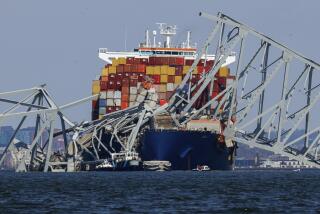Fumes, Devotion Threaten Historic Irish Cross
- Share via
KELLS, Ireland — The people of this ancient Christian settlement are trying to figure out how to have their cross and save it too.
The Market Cross, the most prized but endangered landmark of Kells, once marked the entrance to the monastic settlement that followers of St. Columba founded in A.D. 804.
Twelve centuries on, the sandstone Celtic monument stands astride the busiest junction in Kells, a magnet for locals, tourists and religious pilgrims.
“It’s been there donkey’s years,” said Alice Mulvenna, 28, who works at a convenience store 20 yards from the cross.
“We’d sit there on the cross as school kids at 2 in the afternoon or 2 in the morning. That’s why there’s such a good shine on it.”
But the cross is suffering. Carvings of Adam and Eve, Cain and Abel, Daniel in the lion’s den, Christ performing the miracle of the loaves and fishes have all been reduced to blobs by a millennium of rain--and, even more, by a few decades of corrosive exhaust.
Every day, 12,000 vehicles pass by the cross. In 1985, a truck sideswiped the cross, taking out a few base stones and nudging the whole structure a few inches.
“If it gets hit clean by one of those juggernauts, that’ll be it--a death blow,” said Frances Monaghan, a town councilwoman.
In her family’s pub there’s a picture, circa 1899, of the cross covered with kids. Such old pictures show much more detail of the carvings than survives now, but she understands local resistance to moving the cross even an inch.
“It’s like our leaning tower of Pisa. How could you move it, really?”
So when the burghers of Kells last year decided to move the cross indoors at a new heritage center and place a replica in the intersection, battle lines were quickly drawn.
“We all agree that it’s in great, continuous danger. The people just feel utter and absolute abhorrence that the Market Cross might be moved,” said Denis McCarthy, a mushroom farmer, frog hunter and secretary of the Save Our Cross Committee.
The group got 1,000 signatures on a petition and organized two protest rallies outside the council chambers last summer.
“You had demonstrations, verbal abuse and even a bit of physical abuse,” said the town’s Anglican minister, the Rev. William Ritchie. “People got quite wound up about it.”
The council has backed down for now, as it had in 1983 when it first proposed moving the cross. It is awaiting an updated road-traffic report later this year before deciding whether to move the cross farther from the road, or into the heritage center.
There has also been talk of banning vehicles from Cross Street and putting the cross under glass.
The “high crosses” are the most distinctive monuments of early Christian Ireland, and controversies over protecting them have troubled other Irish towns in the 1990s. Conservationists prevailed and deteriorating crosses were shifted in Tuam, County Galway, in 1992 and the monastic site at Clonmacnois, County Offaly, in 1991.
It’s a peculiarly emotive issue in Kells, 35 miles northwest of Dublin. Tradition-minded locals call the town by its Gaelic name of Ceanannas Mor, and often say “God bless” at the close of conversations.
The Columban monastery produced the Book of Kells, a lavishly illustrated Bible now safely displayed at Trinity College in Dublin.
There are three other high crosses in Kells in the much safer confines of the cemetery of St. Columba’s, the local parish of the Church of Ireland, the Protestant church that until 1867 was the official church of British-ruled Ireland.
Ritchie says the monuments attract people from far and wide, including a New York nun who comes each year with a crowd of pilgrims.
“It’s very powerful to begin at the Market Cross and then walk uphill to the quieter crosses, as it were,” he said.
“Standing there amid the traffic really brings it home, to have the cross in the middle of the marketplace. It helps you to remember the conflict that has often arisen, in the Gospels and since, between commerce and spirituality.”
Ritchie says he tells departing pilgrims: “I don’t know if the cross will be here when you come back.”
Michael Allen, chairman of the Urban District Council, says the cross will have to move eventually--”the sooner the better, though I imagine it will be later.”
Peter Harbison, the foremost authority on the island’s approximately 200 Celtic stone crosses, said the Market Cross is “probably the most endangered of all high crosses in the country.
“If it were to be seriously damaged, our present generation would never forgive itself,” Harbison said.
More to Read
Sign up for Essential California
The most important California stories and recommendations in your inbox every morning.
You may occasionally receive promotional content from the Los Angeles Times.












